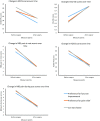Meeting patient expectations: patient expectations and recovery after hip or knee surgery
- PMID: 29168164
- PMCID: PMC6223986
- DOI: 10.1007/s12306-017-0523-7
Meeting patient expectations: patient expectations and recovery after hip or knee surgery
Abstract
Background: Although patient-centred care could help increase the value of healthcare, practice variations in hip and knee surgery suggest that physicians guide clinical decisions more than patients do. This raises the question whether treatment outcomes still meet patients' expectations. This study investigated whether treatment outcomes measured by patient-reported outcome measures fulfil patients' main expectations (i.e. decreased pain or improved functioning).
Methods: Patients who underwent hip or knee surgery in 20 Dutch hospitals in 2014 were invited to a survey consisting of the KOOS Physical Function Short Form or the HOOS Physical Function Short Form, the NRS pain and the EQ-5D. Patients were asked their main reason for surgery and whether the expectations regarding this reason were fulfilled.
Results: A total of 2776 patients completed the survey. The most common reason for surgery was improved functioning (43.7%). Patients who were unable to choose between pain relief and improved functioning and patients who aimed for pain relief experienced more problems before surgery. However, patients who were unable to choose improved more than patients who wanted to improve their functioning on the NRS pain during use and the EQ-5D. More patients who aimed for pain relief felt that their expectations were fulfilled compared to other patients.
Conclusions: Although an expectation for an outcome was not related to a greater improvement on that outcome, patient expectations were an indication of patients' improvement due to surgery. Differences in expectation fulfilment may be due to unrealistic expectations. To achieve optimal value, tailoring treatment using patient preferences and managing patient expectations is vital.
Keywords: Hip and knee surgery; Patient expectations; Patient preferences; Patient-reported outcome measures.
Conflict of interest statement
The authors declare that they have no competing interests.
Figures
Similar articles
-
Patients' pre-operative general and specific outcome expectations predict postoperative pain and function after total knee and total hip arthroplasties.Scand J Pain. 2018 Jul 26;18(3):457-466. doi: 10.1515/sjpain-2018-0022. Scand J Pain. 2018. PMID: 29794270
-
Patient expectations and satisfaction 6 and 12 months following total hip and knee replacement.Qual Life Res. 2020 Mar;29(3):705-719. doi: 10.1007/s11136-019-02359-7. Epub 2019 Nov 18. Qual Life Res. 2020. PMID: 31741216
-
A High Proportion of Patients Have Unfulfilled Sexual Expectations After TKA: A Prospective Study.Clin Orthop Relat Res. 2020 Sep;478(9):2004-2016. doi: 10.1097/CORR.0000000000001003. Clin Orthop Relat Res. 2020. PMID: 32023235 Free PMC article.
-
The emotional state of the patient after total hip and knee arthroplasty.Clin Orthop Relat Res. 2007 Oct;463:7-12. Clin Orthop Relat Res. 2007. PMID: 17960669 Review.
-
Results of total joint arthroplasty and joint preserving surgery in younger patients evaluated by alternative outcome measures.Dan Med J. 2014 Apr;61(4):B4836. Dan Med J. 2014. PMID: 24814600 Review.
Cited by
-
"Life Without Symptoms" or "Being Able to Enjoy Life": What does it Mean to be "Well" After Cancer?J Cancer Educ. 2024 Apr;39(2):204-210. doi: 10.1007/s13187-023-02397-3. Epub 2023 Dec 29. J Cancer Educ. 2024. PMID: 38155282
-
What Outcomes Matter to Patients After Joint or Spine Surgery?J Patient Cent Res Rev. 2020 Apr 27;7(2):157-164. doi: 10.17294/2330-0698.1738. eCollection 2020 Spring. J Patient Cent Res Rev. 2020. PMID: 32377549 Free PMC article.
-
What recovery domains are important following a total knee replacement? A qualitative, interview-based study.BMJ Open. 2024 May 9;14(5):e080795. doi: 10.1136/bmjopen-2023-080795. BMJ Open. 2024. PMID: 38724049 Free PMC article.
-
What patients want to know, and what we actually tell them: The ABIDE project.Alzheimers Dement (N Y). 2020 Dec 16;6(1):e12113. doi: 10.1002/trc2.12113. eCollection 2020. Alzheimers Dement (N Y). 2020. PMID: 33344753 Free PMC article.
-
Predictors of met expectations two years after knee surgery.J Orthop. 2021 Apr 1;25:10-15. doi: 10.1016/j.jor.2021.03.022. eCollection 2021 May-Jun. J Orthop. 2021. PMID: 33897134 Free PMC article.
References
-
- America IoMCoQoHCi . Crossing the quality chasm: a new health system for the 21st century. Washington: National Academy Press; 2001. - PubMed
MeSH terms
LinkOut - more resources
Full Text Sources
Other Literature Sources
Medical


